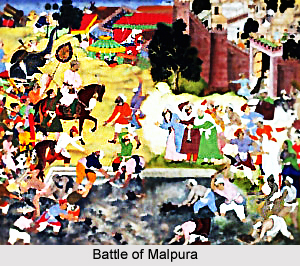 In the year 1800, a crisis developed between the relationship of Jaipur and Sindhia`s Government. The burden of money contribution started to grow as a great pressure to all the Rajput States and a new hope began to come down in their hearts from the news of the civil war between Sindhia and Holkar in Pune, during the commotion of Daulat Rao Sindhia`s management, his persecution of his old and able servants, and above all his quarrel with the widows of the great Mahadji, known as the Bhais` war. This last dispute originated many affairs among the Sindhia in North India into the greatest confusion, while all his officers were ranged in the rival defenses and engaged themselves in fighting one another.
In the year 1800, a crisis developed between the relationship of Jaipur and Sindhia`s Government. The burden of money contribution started to grow as a great pressure to all the Rajput States and a new hope began to come down in their hearts from the news of the civil war between Sindhia and Holkar in Pune, during the commotion of Daulat Rao Sindhia`s management, his persecution of his old and able servants, and above all his quarrel with the widows of the great Mahadji, known as the Bhais` war. This last dispute originated many affairs among the Sindhia in North India into the greatest confusion, while all his officers were ranged in the rival defenses and engaged themselves in fighting one another.
Sawai Pratap Singh made an attempt to profit by these internal dissensions of his enemy prior the battle of Malpura. In March 1800, he openly rejected the money clauses of the treaty of 1791 and started to prepare for war. The battle of Malpura thus started.
Hearing of the preparations made by the Jaipur Rajas for the war in his camp at Sanganer, Lakhwa Dada gathered his own troops and took their position four miles south of Malpura, which is a town about 55 miles south-west of Jaipur. His army consisted of De Boigne`s second brigade or the six battalions commanded by Pohlman, a Hanoverian, Chevalier Dudrence`s brigade comprised of six battalions, supplied by Holkar, two battalions of Lakhwa`s own contingent and a battalion furnished by the Kota regent and a body of incompetent Maratha light horse that is a total of about 16,000 men. The Jaipur army was made by 18 battalions of musketeers, 2000 Naga Gosains, 1000 Ruhelas and more than 15,000 Rajput cavalry, including 5000 Rath or horsemen from Jodhpur that was led by Sawai Singh and a total of 27,000 men, besides 54 pieces or artillery, ranging from 24 pounders to six pounders.
South of the Sohadra River channel the Maratha army lay encamped near the village of Hindoli. The Jaipur army came and settled north of this channel, with the town of Malpura on their left side.
Lakhwa Dada surprised the Jaipur army by setting his troops in action at four o`clock early in the morning of 16th April. His army was gathered in two lines, the first being formed by Pohlman`s brigade (right) and Dudrence`s (left), while the second was marching a thousand paces behind the first line was made up of the Maratha cavalry, these pushing forward some meters of land to the two sides of the first line to guard their edges. The light field pieces of each brigade moved before it. The Rajput right was composed of the Rathors and the left of the Kachhwa troops.
Lakhwa Dada`s surprised attempt however failed, as the Jaipur troops got the alert signal and through the recklessness of the cavalry patrols of the Marathas before the infantry had forded the river. A heavy barrage was established all along their line. On this, Major Pohlman ordered the second crew to move forward with its guns but reserve its fire until they were close to the enemy. These orders were accordingly obeyed and his artillery also performed well. Sweeping across the 500 yards of open space from the riverbank to the line of Jaipur guns, Pohlman`s infantry took 40 of them and sacrificed some of their own men. But the toughest part of the battle of Malpura now began, when the Rathor cavalry charged the Dudrence`s brigade (the left of their front line), during the close engagement on the right.
The Rathors were seen approached from a distance; the tramp of their enormous and compact body rose like thunder above the roar of battle. The well-served guns of the brigade showered upon their dense mass, thus cutting down hundreds at every discharge. Holkar`s infantry was a new brigade and was not sufficiently trained. As a result, the left wing of the Deccan army was furrowed up in one short onset, 320 men being slain or wounded out of a total strength of about 2400. The victorious Rathors did not look for their Kachhwa comrades, swept onward after the grand success, and covered the thousand paces up to the second line in a twinkle. Here the Maratha cavaliers did not wait to meet the shock, but ran away like sheep.
Sawai Pratap Singh retired to Jaipur, with his army, but all his camp and baggage and guns were captured. Pohlman`s brigade had 75 casualties and Dudrence`s 320, but these were only the first rough estimates (Asiatic Annual Register for 1800). Peace was made soon afterwards.






































